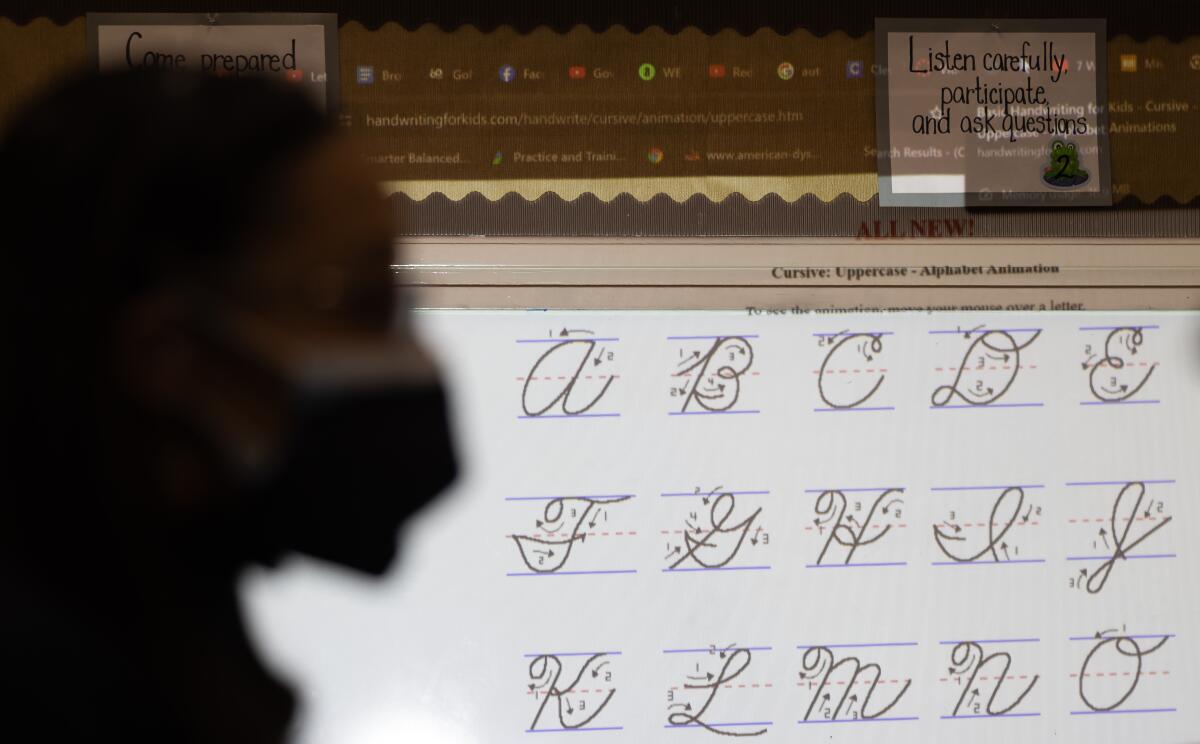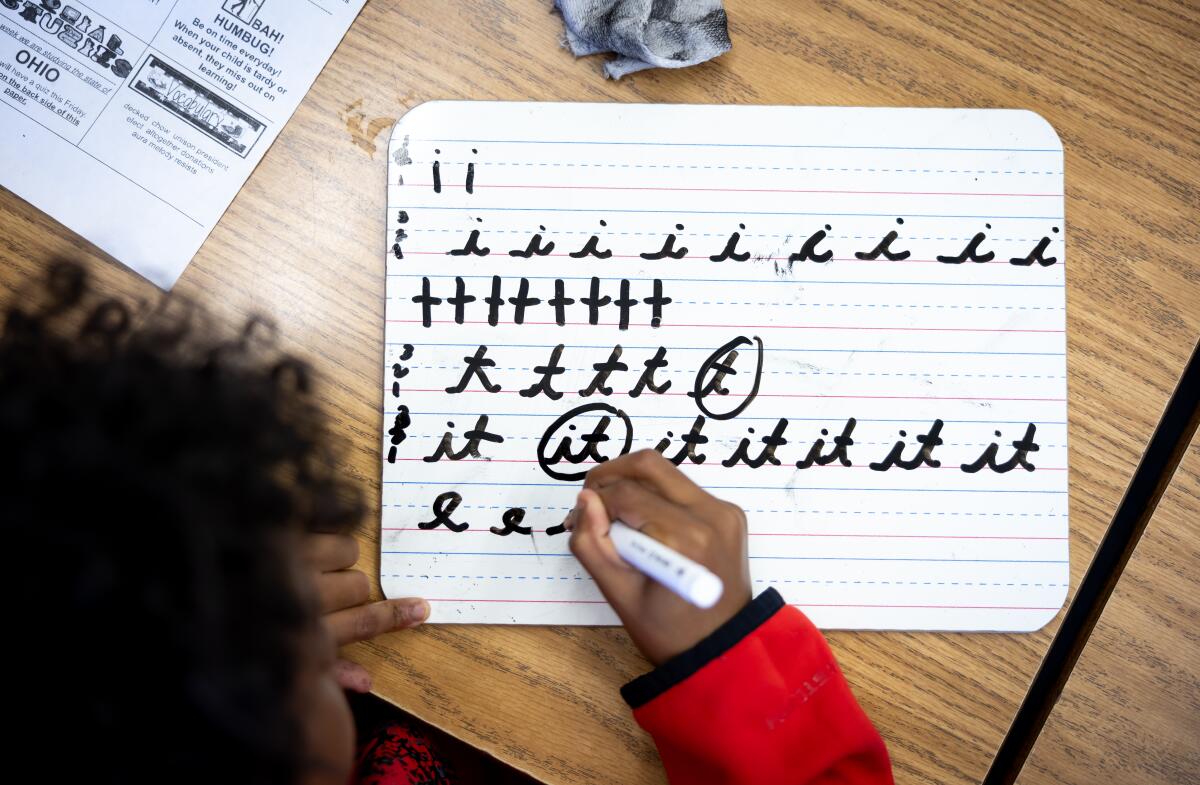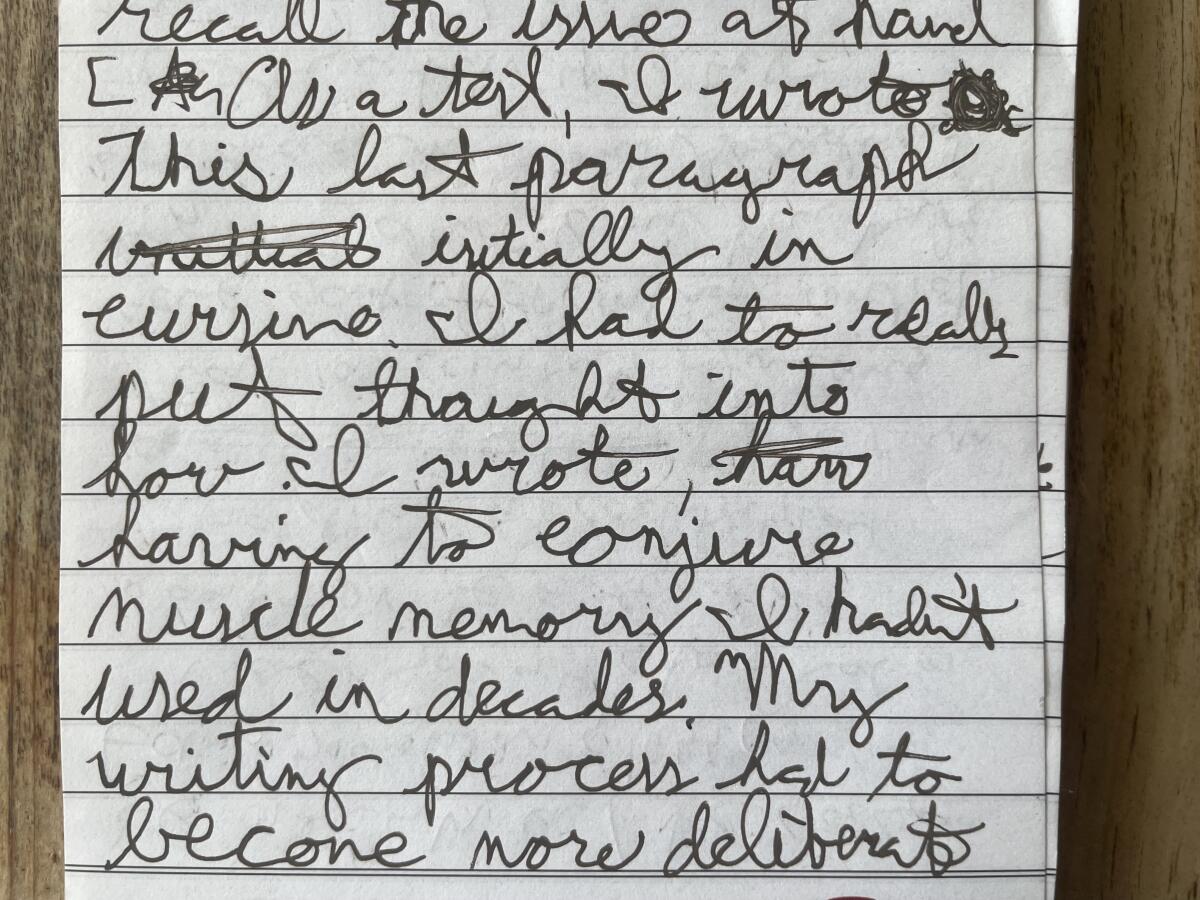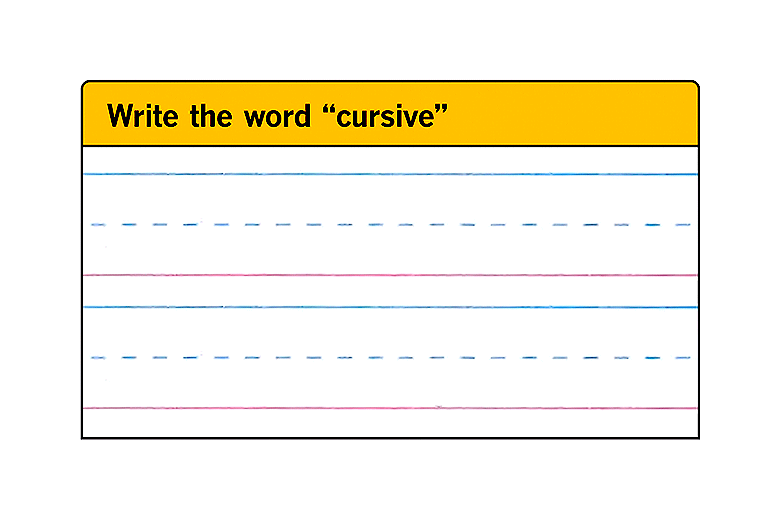Column: Don’t force kids to learn cursive. Mine is terrible, and I’m doing just fine

“Messy! Messy!”
Nearly 40 years later, the admonishments of my second-grade teacher at Thomas Jefferson Elementary in Anaheim still ring in my ears.
“Messy! Messy!”
I was a precocious 8-year-old, placed in a third-grade class for history, math and reading — but not English. My stumbling block: cursive writing.
“Messy! Messy!”
For weeks, our teacher lectured on this new way to communicate. I still remember some of the mnemonic tricks she used for some of the harder letters. Put a hat on “O,” small and large. Widen the space between the two bubbles that make up a “K.” Straighten those arches on Ms and Ns, and don’t forget the little left arm on capital “I.”
She was kind and supportive to most of my classmates. But when she approached my desk to look at my scrawls, she almost always grabbed the lined paper, shook it and did her best “Mommy Dearest” impression while proclaiming, “Messy! Messy!” loud enough so the rest of the class could hear.
I tried to get better, but the daily humiliations wrecked my writing style for good. To this day, my notes look like something between cuneiform and the lines from furniture on wooden floors after decades of wear and tear.
Teaching cursive is once again the law for kids in California — news that adults greet with celebration, nostalgia, scorn, indifference and head-scratching.
If I could talk to my second-grade teacher today — the only one of my elementary school teachers whose name I can’t remember, because she upset me that much — I would tell her that she was unnecessarily cruel and that ridiculing young minds in front of others does nothing to improve them. And then I’d tell her I had the last laugh. Lousy penmanship didn’t stop me from becoming someone whose profession depends on shaping letters. Being incompetent in cursive didn’t hold me back one bit.
That’s why I had such a visceral reaction to a new California mandate that public schools teach cursive to students at some point between first and sixth grade. Fullerton-area Assemblymember Sharon Quirk-Silva, who authored the legislation that Gov. Gavin Newsom signed into law in October, described it in a press release as “an issue of equity.” Cursive “enhances a child’s brain development, including memorization, and improves fine motor skills,” she wrote.
So does playing chess, but I don’t see Newsom appointing grandmaster Magnus Carlsen as secretary of education.
Quirk-Silva is a former elementary school teacher in her hometown and one of the few good politicians Orange County has produced, so I know her push came from a good place. Nevertheless, mandating cursive for kids is California liberalism at its worst.
In California, chronic absenteeism is more than twice the pre-pandemic rate. On state tests, more than half of K-12 students don’t meet standards in math and reading. Of all the issues our children have to deal with today, a forced return to cursive is what our legislators think they need?

In a world where most people text and email, cursive handwriting just isn’t a skill everyone needs to know. It’s about as academically relevant to today’s students as Sadie Hawkins Day, and as necessary as a dunce cap.
The arguments that advocates cited in a Jan. 8 story by my colleague, education reporter Howard Blume, are well-meaning but trifling. Writing in connected loops slows students down and makes them appreciate the value of thinking? So does gardening. Cursive makes young scholars use their brain and their hands at the same time, thereby improving memory and critical thinking? Give them a Rubik’s Cube. Not knowing cursive will hinder future generations from reading the correspondence and archival documents of our ancestors? Many children of immigrants can’t read, write or speak the language of their parents — shouldn’t that be a more pressing matter?
Cursive allows people to create their own personal signatures? I guess — but society used to allow an “X” on important documents. Besides, didn’t Prince once go years using a symbol for his name?
Teaching of cursive writing returns after falling to the wayside amid revised learning standards and emphasis on keyboarding. Backers say it promotes learning.
None of what I’m saying is a knock against the writing form. It is elegant, and I’m all for anything that promotes literacy. But bringing it back on a widespread level won’t unlock a golden era of educational attainment that previous generations were somehow privy to. Those who came before us also absorbed things in school no one’s pining to bring back, like corporal punishment or Manifest Destiny.
How we put down our thoughts evolves, because that’s what a smart society does — after all, Egyptians don’t use hieroglyphics anymore, nor do Scandinavians use runes. Hell, when was the last time you saw a kid use a slab of slate to jot down assignments?
If young people want to learn cursive, they should do it as an elective in junior high and high school, when students pursue interests that are cool but not necessary to one’s development. That’s how I encountered a Macintosh for the first time in seventh-grade computer science and learned how to type in 10th grade, courtesy of Mr. McCloskey at Anaheim High. Back then, California’s educational poobahs saw computers and typing as auxiliaries to learning instead of the essential skills we view them as today. Thank God we now at least have computer science standards starting in kindergarten — and I hope required typing classes will soon follow in middle school.

But, hey: Maybe I’m letting my bad second-grade experience cloud my judgment? So as a final assignment, I wrote out this final part of my columna in my topsy-curvy finest.
It was hard. I had to conjure up muscle memory I hadn’t channeled in decades. I did have to put more thought into what and how I wrote, and the end results were far more legible than what I usually produce. But I didn’t feel more enlightened, or fulfilled, when I finished.
Cursive is for when you have nothing else to do, or want to live out some steampunk fantasy. Typing, voice dictation technology or my usual chicken scratch would’ve done the job far faster. Maybe cursive works for love letters — but roses do the job better. Emojis, even.
Hey, Sharon: Let’s start a class on emojis!
More to Read
Sign up for Essential California
The most important California stories and recommendations in your inbox every morning.
You may occasionally receive promotional content from the Los Angeles Times.













